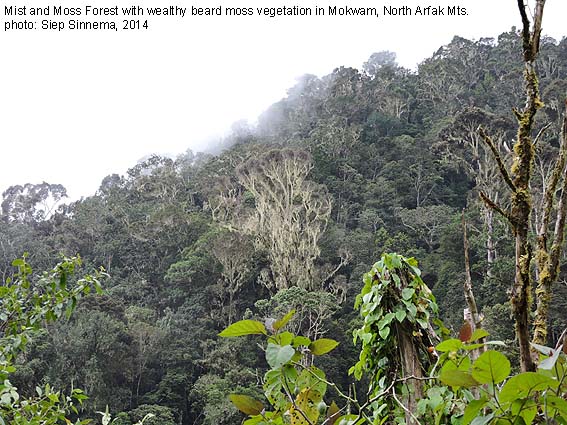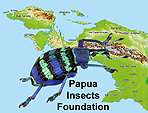



December 2014
(updated on 1st December 2014)
other issues of our Newsletter:
August 2008 - March 2009 - November 2009 - October 2010 - December 2011 - May 2013 - December 2013 - April 2014
Papua-Insects.nl
The Papua Insects Foundation
The latest news of the Papua Insects Foundation, the website and other relevant items concerning the entomology study in New Guinea
With this newsletter we want to inform you about the latest developments, news and changes in the website and activities of the Papua Insects Foundation and other interesting entomological news of New Guinea. If you have any questions or comments on this, please contact us.
Delay with release and sending of SUGAPA magazine
Subscribers of the SUGAPA magazine probably already noticed that since volume 8(3) from January-March 2014 it took a long time before another volume had been released. The editorial board of SUGAPA would like to inform you that in July 2014 there still was not received sufficient copy for SUGAPA 8(4). Eventually, at 31st October it has been issued. However, some logistic problems in Jayapura caused delay in sending, which is the reason that many subscribers did receive issue 8(4) very late for which the board apologizes.
Volume 8(5) has already been printed and it will be posted before 10th December 2014.
Volume 9 is starting in 2015 and the first issue will be sent in February.
Volume 8(4) (April - June 2014) of SUGAPA is released
For the contents of this and previous issues see the abstracts of SUGAPA
The sixth expedition of the Papua Insects Foundation to the Birdshead Peninsula and FakfakFrom 15th October to 14th November 2014 a team of four people visited Papua Indonesia for the sixth expedition of the Papua Insects Foundation. This time the focus was on the Birdshead Peninsula (Doberai Peninsula or Kepala Burung) and on the region of Fakfak (Onin Peninsula).
Members of the survey were Frans Groenen, Jannie Sinnema, Siep Sinnema and Piet Zumkehr, all four were especially interested in Lepidoptera. Frans and Siep also made thousands of pictures of moths and butterflies.
On the Birdshead Peninsula the Arfak Mountains (Mokwam, Demaisi) and Senopi in the centre of the Birdshead Peninsula in the Tamrau Plateau were visited. The visit to the Fakfak region was especially interesting and new contacts were made.
The contacts with UNIPA, the University of Manokwari, were expanded and new contacts were made with Villanova, a secondary school in Manokwari.
UNIPA
In Manokwari the "Universitas Negeri Papua" (UNIPA) was revisited and teacher and entomologist Mrs. Drs. Rawati Panjaitan was met. Mr. Hengky Wambrau, who is a botanist at UNIPA, cooperated with the team. The members of the team gave lectures about butterflies and moths to students of UNIPA. These lectures were attended to by about 60 students, followed by an excursion to Gunung Meja with about 30 students. The students were very interested during the lectures and the excursion. With Rawati Panjaitan plans were made for further cooperation in the future.
Mokwam
Mokwam is a small village at the Northside of the Arfak Mountains at 1500 meters, surrounded by mist forest with wealthy beard moss vegetation. Mokwam is well attainable by 4x4 cars and has a new accomodation, run by Zeth Wonggor. Zeth, his wife and his son Elyakim were very helpful during the stay in Mokwam. Many bird watchers visit this place for the famous Bower Birds and Birds of Paradise, but more important, Mokwam proved again to be very successful for surveying insects. Three nights were spent in Mokwam and every night was successful for collecting moths.
Demaisi
Two nights were spent in Demaisi, a village higher in the mountains at 1637 m. Zeth Wonggor accompanied the team to Demaisi and helped to get a place to sleep and the cooking. Both nights were successful for moth collecting. The people of the village recognized some team members from the visit in 2011 and were very helpful and friendly again.
Fakfak
The team of the Papua Insects Foundation visited Fakfak for the first time. Mr. Frans Tamaela, a friend of Henk van Mastrigt, was so kind to arrange a guide, Jack Gewab, who could speak English very well and accompanied the team during the 7 days stay in Fakfak and its surroundings.
Two days were spent in the small village Werba where was slept under a plastic shelter in the forest and the daughters of the head of the village provided the team with food and hot water. Both nights were suitable for collecting moths.
The next two days Huri-Mber was visited, a small village in the central mountains of the Onin Peninsula at about 600 m. Huri-Mber is a very good place for surveying moths and the light and sheet were mounted both nights on a hilltop near the village.
The last place visited was Air Besar, near the coast and east of Fakfak. Just one night was enough to notice that it was not very successful for moths.
The team is very thankful to Mr. Frans Tamaela for his help during the stay in Fakfak.Senopi
The village Senopi is located in the centre and lowland of the northern Birdshead Peninsula, near the Tamrau Mountains. Traveling from Manokwari to Senopi is possible by 4x4 car. The road between Manokwari and Senopi is rough in the mountains but has been improved compared to three years ago. In the plains around Senopi new bridges were built over the rivers to avoid problems with the usual "banjirs". Unfortunately Pastor Yan was no longer in Senopi, however, the hospitality of the people of Senopi was heartwarming again and the team could stay again in the guesthouse, which is quite luxurious for the area. Lientje was cooking and prepared a hornbill (burung tahun) for dinner. The weather had been very dry during the last period which resulted in low numbers of moths, however, many good and new species were found.
Manokwari
During the stay in Manokwari trips were made to Warkapi, Maripi, Gunung Meja and the waterfall near the airport. Father Tromp is the head of the secondary school Villanova in Manokwari. He had useful information about the situation in Senopi. At one of the last days in Manokwari a demonstration of collecting at light was arranged on Villanova for about 40 students who were very interested.
All pages with new pictogram buttons
The above depicted pictogram buttons replaced the old blue buttons, which should make surfing and navigating through the website much easier. The pictograms should speak for themselves which function they have and if not, the text in it will do.
Thumbnail pages
As usual new thumbnail galleries have been added to the website and more are yet to come. Renovations and corrections in the website are part of a daily practice to keep the website up to date and are ongoing. Here follows a list of the major novities on the website since last newsletter. Minor changes are numerous and you will understand that we cannot list those.
Checklists
Of the insects pages the following list shows the new or renewed checklists
- Dermaptera: The earwigs of Papua (Christophe Girod) [November 2013]
- Lepidoptera: Pieridae (Henk van Mastrigt) Most of the species pages ready [December 2013]
- Lepidoptera: Lycaenidae (Stefan Schröder) A start is made with species pages [December 2013]
- Lepidoptera: Uraniidae (Siep & Jannie Sinnema) A checklist and many species pages ready [March 2013]
- Lepidoptera: Notodontidae (Alexander Schintlmeister) A checklist of the species and a start with species pages [July 2013]
- Lepidoptera: Euteliidae (Rob de Vos) Checklist with species pages ready [November 2014]
- Lepidoptera: Nolidae (Rob de Vos) All checklists with species pages revised and updated [July 2014]
We hope that contributors who promissed us a checklist of their insect group will soon send it to us for preparing. If you have additional information or a new family to add to the website please contact the webmaster.
Available thumbnails at this moment are:
- Orthoptera: Tetrigidae
- Odonata: Anisoptera
- Odonata: Zygoptera
- Hemiptera: Auchenorrhyncha (Cicadidae, Tibicinidae)
- Hemiptera: Auchenorrhyncha (Fulgoridae, Flatidae)
- Hemiptera: Heteroptera (Pyrrhocoridae, Miridae, Tessaratomidae)
- Hemiptera: Heteroptera (all families, unidentified specimens)
- Coleoptera: Anthicidae
- Coleoptera: Carabidae
- Coleoptera: Dytiscidae
- Coleoptera: Cerambycidae (Lamiinae)
- Coleoptera: Cerambycidae (Prioninae)
- Coleoptera: Cerambycidae (Cerambycinae)
- Coleoptera: Cicindelidae
- Coleoptera: Curculionoidea, Brentidae
- Coleoptera: Curculionoidea, Curculionidae
- Coleoptera: Curculionoidea, Attelabidae
- Coleoptera: Endomychidae
- Coleoptera: Scarabaeidae (Cetoniinae)
- Coleoptera: Lucanidae
- Lepidoptera: Hepialidae
- Lepidoptera: Cossidae
- Lepidoptera: Psychidae
- Lepidoptera: Alucitidae
- Lepidoptera: Pterophoridae
- Lepidoptera: Tortricidae
- Lepidoptera: Uraniidae
- Lepidoptera: Sphingidae
- Lepidoptera: Papilionidae [under construction]
- Lepidoptera: Pieridae
- Lepidoptera: Lycaenidae [under constructions]
- Lepidoptera: Drepanidae (Thyatirinae)
- Lepidoptera: Drepanidae (Drepaninae)
- Lepidoptera: Erebidae (Aganainae)
- Lepidoptera: Erebidae (Erebinae) [under construction]
- Lepidoptera: Erebidae (Arctiinae, Lithosiini) [under construction]
- Lepidoptera: Erebidae (Arctiinae, Arctiini)
- Lepidoptera: Erebidae (Arctiinae, Syntomini)
- Lepidoptera: Euteliidae (Euteliinae)
- Lepidoptera: Euteliidae (Stictopterinae)
- Lepidoptera: Notodontidae
- Lepidoptera: Noctuidae (Agaristinae)
- Lepidoptera: Noctuidae (Plusiinae)
- Lepidoptera: Noctuidae (Pantheinae)
- Lepidoptera: Noctuidae (Dyopsinae)
- Lepidoptera: Nolidae (Bleninae)
- Lepidoptera: Nolidae (Nolinae)
- Lepidoptera: Nolidae (Chloephorinae)
- Lepidoptera: Nolidae (Collomeninae)
- Lepidoptera: Nolidae (Risobinae)
- Lepidoptera: Nolidae (Westermanniinae)
Appeal for more information on other insect groups and items for the next newsletter
At the moment we have contact with more than 50 entomologists in the world who more or less contribute to our website or promissed to do so. We would appreciate your cooperation to provide us of information and checklists of your specialism concerning New Guinea in general or Papua Indonesia in particular. If you know of some other specialists who potentially could be interested to contribute to our website, please let him/her know of us or inform us.
If you have interesting news or information to put in the next newsletter you are very welcome to. Please contact the webmaster to deliver and discuss your contribution.
We rely and depend on you!